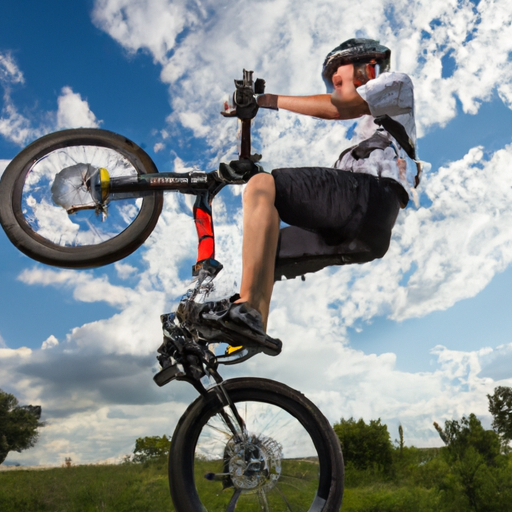Hey there, E-Bike enthusiasts! In our “Advanced E-Bike Riding Tips” section, we are here to take your riding skills to the next level. From advanced security measures to extreme uphill climbing techniques, we have got you covered. For those who are passionate about e-biking and want to get the most out of their rides, this is the place to be. Whether you are an intermediate or advanced e-bike rider, we have content tailored just for you. And today, we are going to delve into the exciting world of wheelies. By learning the wheelie basics, you can elevate your riding skills and add some flair to your e-bike adventures. So, let’s get started and master this awesome technique together!

Introduction to E-Bike Wheelies
Understanding the Wheelie
Let’s start by understanding what a wheelie is. In simple terms, a wheelie is a maneuver where you lift the front wheel of your e-bike off the ground and balance on just the rear wheel. It might sound intimidating, but with the right technique and practice, anyone can learn how to do a wheelie.
Benefits of Learning Wheelies
Learning how to do a wheelie on your e-bike has several benefits. First and foremost, it’s a fun and exciting skill to have in your riding repertoire. It adds a sense of thrill and adventure to your rides, making them more enjoyable. Additionally, wheelies can help you improve your bike control and technical skills, which can be beneficial in various riding scenarios.
Safety Precautions
Before we delve into the step-by-step guide for performing a wheelie, it’s crucial to prioritize your safety. Make sure you have the necessary safety gear, such as a helmet, knee pads, and elbow pads. It’s also important to practice in a controlled environment away from traffic and obstacles. Remember, safety should always be your top priority when attempting any advanced riding technique.
Preparing for the Wheelie
Choosing the Right Location
Finding the right location is crucial for practicing wheelies. Look for a flat, open space with a smooth surface, preferably away from traffic. Avoid areas with loose gravel or potholes, as they can make balancing and control more challenging.
Ensure Proper Bike Setup
Before attempting a wheelie, it’s essential to ensure that your e-bike is properly set up. Check that your tires are inflated to the recommended pressure and that your brakes are in good working condition. Proper bike setup is vital for maintaining control and reducing the risk of accidents during a wheelie.
Wearing Appropriate Gear
When attempting wheelies or any other advanced riding technique, wearing appropriate gear is crucial. Make sure to wear a well-fitted helmet, knee pads, elbow pads, and any other protective gear that you feel comfortable with. This will minimize the risk of injuries in case of a fall or loss of balance.
Warm-up and Stretching
Before attempting any advanced riding technique, it’s essential to warm up your body and stretch your muscles. This will help prevent injuries and increase your flexibility. Spend a few minutes engaging in light physical activity, such as jogging or jumping jacks, followed by a series of stretching exercises targeting your legs, core, and upper body.
Step-by-Step Guide to Performing a Wheelie
Starting Position
To begin your wheelie, start in a low gear and pedal until you reach a moderate speed. Keep your body centered on the bike with your feet parallel to the ground. Make sure your arms are slightly bent, and your weight is evenly distributed.
Pedal Placement
As you approach the wheelie, position your pedals at the three and nine o’clock positions. This will give you a stable base to push off from when lifting the front wheel. Keep your feet firmly planted on the pedals and maintain a relaxed grip on the handlebars.
Weight Distribution
To initiate the wheelie, shift your weight slightly towards the rear of the bike. Lean back and put more pressure on the pedals with your feet. This will help transfer your weight to the rear wheel, allowing you to lift the front wheel off the ground.
Initiating the Wheelie
As you shift your weight back and increase pressure on the pedals, use a combination of your arms and legs to push down on the handlebars while simultaneously pulling up on the pedals. This explosive motion will lift the front wheel off the ground. Remember to maintain a controlled and smooth movement rather than yanking the handlebars.
Balancing and Maintaining Control
Once the front wheel is off the ground, use your body and leg movements to balance and maintain control. Keep your gaze focused ahead and use your body to counterbalance any shifts in weight. Make small adjustments by slightly extending or bending your arms and legs to maintain stability.
Correcting the Wheelie
During a wheelie, it’s normal to experience slight deviations in balance. If you feel yourself leaning too far back, gently push forward on the handlebars to bring the front wheel down. Conversely, if you feel like you’re losing balance and tipping forward, lean back slightly while applying more pressure on the pedals.
Landing Safely
As you approach the end of your wheelie, it’s important to prepare for a safe landing. Gradually decrease the pressure on the pedals and allow the front wheel to lower back to the ground. Keep your arms slightly bent, ready to absorb any impact, and maintain a relaxed posture. Land softly and smoothly to minimize stress on your bike and body.
Common Mistakes and Troubleshooting
Lifting the Front Wheel Too High
One common mistake when learning wheelies is lifting the front wheel too high. It’s important to remember that a controlled wheelie doesn’t require lifting the front wheel too high off the ground. Practice finding the right balance, gradually increasing the lift as you gain confidence and control.
Losing Balance
Maintaining balance during a wheelie can be challenging, especially when you’re just starting. If you find yourself losing balance, try to relax and make small adjustments to your body position. Keep practicing and gradually build up your balance and control.
Lack of Control
If you feel like you’re struggling with control during a wheelie, it might be helpful to practice basic bike handling skills first. Focus on improving your balance, braking, and steering techniques before attempting more advanced maneuvers like wheelies.
Not Enough Power or Momentum
Having enough power and momentum is crucial for performing a smooth and controlled wheelie. Make sure you’re in an appropriate gear and have enough speed before attempting the wheelie. Practice pedaling with power and efficiency to generate the required momentum.
Overcorrecting
Overcorrecting is a common mistake when trying to find the right balance during a wheelie. It’s important to make small, gradual adjustments rather than jerky and abrupt movements. Practice maintaining a smooth and controlled motion to avoid overcorrecting.
Dealing with Fear and Confidence Issues
Learning wheelies can be intimidating, especially if you’re not used to riding on just the rear wheel. It’s important to take it at your own pace and gradually build your confidence. Start with small progressions and practice in a controlled environment. Over time, with consistent practice, you’ll find your fear diminishing and your confidence growing.

Progressing Beyond Basic Wheelies
One-Handed Wheelies
Once you’ve mastered the basic wheelie, you can challenge yourself further by attempting one-handed wheelies. Start by lifting one hand off the handlebars while maintaining your balance and control. As you become more comfortable, practice lifting the other hand as well.
Manuals and Nose Wheelies
Beyond regular wheelies, there are other variations you can explore. Manuals involve lifting the front wheel off the ground without pedaling but by using your body movements and balance. Nose wheelies, on the other hand, focus on lifting the rear wheel off the ground while keeping the front wheel planted. These advanced techniques require practice and mastery of the basic wheelie first.
Variations and Styling
Once you’ve become proficient in basic wheelies, you can start exploring different variations and styles. Get creative with your wheelies by adding twists, turns, and unique movements. Experiment with different body positions and find your own personal style.
Combining Wheelies with other Tricks
As you become more comfortable with wheelies and advanced riding techniques, you can start combining wheelies with other tricks. Try incorporating wheelies into jumps, drops, or manuals for a more dynamic and impressive riding style.
Safety Tips and Precautions
Wearing Protective Gear
When practicing wheelies or any advanced riding technique, it’s essential to wear the proper protective gear. This includes a well-fitted helmet, knee pads, elbow pads, and any other gear that provides adequate protection.
Practicing in Controlled Environments
To minimize the risk of accidents or collisions, it’s important to practice wheelies in controlled environments. Look for open spaces away from traffic, pedestrians, and obstacles. Empty parking lots or flat grassy fields are ideal locations for practicing wheelies.
Being Aware of Surroundings
While practicing wheelies, it’s crucial to be aware of your surroundings. Keep an eye out for any potential hazards, such as uneven terrain, obstacles, or other riders. Maintaining situational awareness will help you ride safely and prevent accidents.
Avoiding High-Traffic Areas
When learning wheelies or performing advanced riding techniques, it’s best to avoid high-traffic areas. Choose locations with minimal traffic to reduce the risk of accidents and distractions. It’s always better to have a safe and uninterrupted practice session.
Knowing Your Limits
It’s important to know your limits when practicing wheelies or any advanced riding technique. Pushing yourself beyond your comfort zone without proper skill and experience can lead to accidents or injuries. Start with small progressions and gradually increase difficulty as you gain confidence and mastery.

Building Confidence and Practicing
Start with Small Progressions
To build your confidence and improve your wheelies, start with small progressions. Begin by practicing short wheelies with small lifts of the front wheel. As you gain control, gradually increase the duration and height of the wheelies. Progress at a pace that feels comfortable and allows you to steadily build your skills.
Gradually Increase Difficulty
Once you feel comfortable with basic wheelies, challenge yourself by gradually increasing the difficulty. Experiment with different pedal pressures, body positions, and balance points. Push yourself to explore new variations and techniques to keep improving.
Consistent Practice
Consistency is key when it comes to learning and mastering wheelies. Set aside dedicated practice sessions, ideally several times a week, to work on your wheelie skills. The more you practice, the more comfortable and confident you’ll become.
Seeking Professional Instruction or Guidance
If you’re struggling to progress or feel stuck in your wheelie journey, consider seeking professional instruction or guidance. A skilled e-bike instructor can provide valuable feedback, pinpoint areas for improvement, and offer specific techniques tailored to your riding style and goals.
Benefits of Wheelies for E-Bike Riders
Improved Bike Control
Learning how to do wheelies can significantly improve your overall bike control. By mastering balance, weight distribution, and body movements, you’ll develop a better understanding of how your bike responds to different inputs. This increased control translates to better handling and confidence on various terrains and riding scenarios.
Enhanced Technical Skills
Wheelies require a combination of technical skills, including power generation, weight shifting, and precise timing. By practicing wheelies, you’ll enhance these technical skills, which can be beneficial in other aspects of your e-bike riding. Whether it’s climbing steep hills, navigating tight corners, or maneuvering through technical trails, your improved technical skills will come in handy.
Increased Fun and Enjoyment
Let’s not forget the fun factor! Wheelies add an extra element of excitement and enjoyment to your e-bike rides. They inject a sense of playfulness and adventure that can make your rides more memorable and fulfilling. So why not elevate your riding experience and have a blast while doing it?
Expanding Riding Abilities
As you master wheelies, you’ll start to unlock new possibilities. The skills and techniques you learn through wheelies can be applied to other advanced riding maneuvers and tricks. This opens up a whole new world of riding opportunities and allows you to push your boundaries as an e-bike rider.

Conclusion
Congratulations, you’ve reached the end of our comprehensive guide to learning wheelies on your e-bike! We hope this article has provided you with all the information you need to get started on your wheelie journey. Remember to prioritize safety, practice in controlled environments, and always wear appropriate protective gear.
Learning wheelies is a skill that requires patience, practice, and perseverance. Don’t get discouraged if you don’t nail it right away. Take it step by step, starting with the basics and gradually progressing to more advanced variations. With consistent practice and the right mindset, you’ll be riding on just your rear wheel like a pro in no time.
So grab your e-bike, find a suitable practice spot, and start elevating your riding skills with wheelies. Embrace the challenge, have fun, and ride responsibly!




